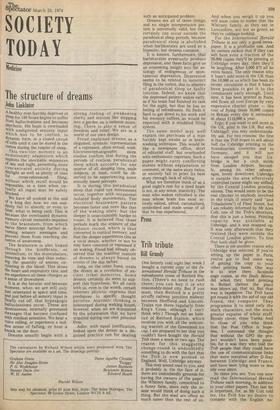SOCIETY TODAY
Medicine
The structure of dreams
John Linklater
A healthy man forcibly deprived of Sleep for 150 hours begins to suffer from hallucinations and becomes Psychotic. His brain is overloaded With undigested sensory input Which has to be carried, in dynamic form, in a closed circuit of cells until it can be stored in the cortex during the respite of sleep. This two-tier memory is an evolutionary adaptation which exploits the inevitable sequences of day and night, permitting more concentrated activity during daYlight as well as plenty of time for cross-referenced filing, Without which recall would be iMpossible, at a time when virtually all input may be safely blocked.
We have all noticed at the end of a long day how we can sud,denly fail to absorb, or even to near, what is being said. This is because the overloaded dynamic Memory circuit transmits impulses to the brainstem, from which nerve fibres intercept further incoming sensory messages and prevent them from reaching the centre of awareness.
The brainstem is also linked through the hindbrain, or cerebellum, to the musculature, 1.0wering its tone and thus reducing the quantity of amines circulating in the blood. This slows the heart and respiratory rate, and We experience all these changes as a sense of drowsiness.
It is at the betwixt and between Moment, when we are still only Just orientated in space and time, and just before all sensory input is finally cut off, that hypnagogic hallucinations occur. These are sPontaneous, internally generated Messages that become confused With residual sensation. We hear a Voice calling, or experience a sudden sense of falling, or hear a knock on the door.
Dreams usually begin with a
strong feeling of awakening clarity and interest like stepping into a garden on a summer morning. There is also a sense of freedom and relief. We are in a world of our own design.
Freud explained dreams as a disguised, symbolic representation of a repressed, often sexual, wish. Electroencephalographic sleep studies confirm that during the periods of restless, paradoxical sleep which accounts for one quarter of all sleeping time, male subjects, at least, could be observed to be experiencing some sexually based percepts.
It is during this paradoxical sleep that rapid eye movements occur, together with occasional isolated body movements. The electrical brainwave pattern becomes faster and more like that of the waking state, but the sleeper is unaccountably harder to rouse. It is believed that these periods mark the erasure of the dynamic record, which is thus converted to cortical memory, and that the sleeper experiences this as a vivid dream, whether or not he may have censored or repressed it on waking. Freud had already observed that the manifest content of dreams is always based on events of the day before.
Jung, on the other hand, treats the dream as a revelation of ancient tribal memories. Some dreams certainly do seem to support this hypothesis. We all carry with us, even in the womb, certain inherent phyletic engrams that predispose to specific thought patterns. Atavistic thinking is submerged during waking hours, however, when we are dominated by the information that we have acquired during our own personal lives.
Adler, with equal justification, looked upon the dream as a disguised practice run for dealing with an anticipated problem.
Dreams are all of these things, and no single interpretation pattern is universally valid, but they certainly can occur outside the paradoxical sleep periods, because paradoxical sleep is abolished when barbiturates are used as a hypnotic, but dreams continue.
It is known, furthermore, that barbiturates eventually produce depression, and these facts give us an interesting insight into the aetiology of endogenous or spontaneous depression. Depression seems to be related to incorrect filing in the cortex, due to absence of paradoxical sleep or faulty function. Indeed, we know that the depressed patient wakes early, as if his brain had finished its task for the night, but that he has no feeling of refreshment. He finds it hard to get down to his work and his memory suffers, as would be expected with a muddled filing system.
The same model may well explain the psychosis of a man forcibly kept awake as in brainwashing technique. This would be like a newspaper office, short of editorial staff, but overloaded with enthusiastic reporters. Such a paper might carry conflicting stories without explanation or comment, or the same story twice, or entirely fail to print its best story through lack of sifting.
What we therefore think of as a good night's rest for a tired brain is not, in any sense, inactivity. The man who wakes refreshed is the man whose brain has most actively edited, sifted, rationalised, symbolised and made sense of all that he has experienced.


































 Previous page
Previous page